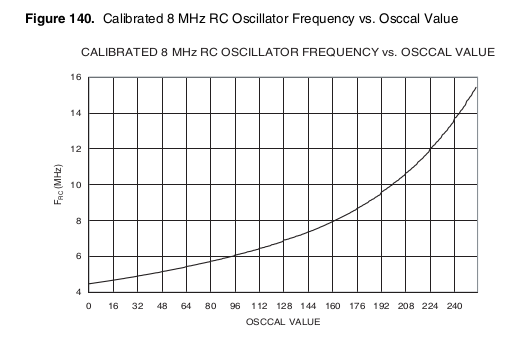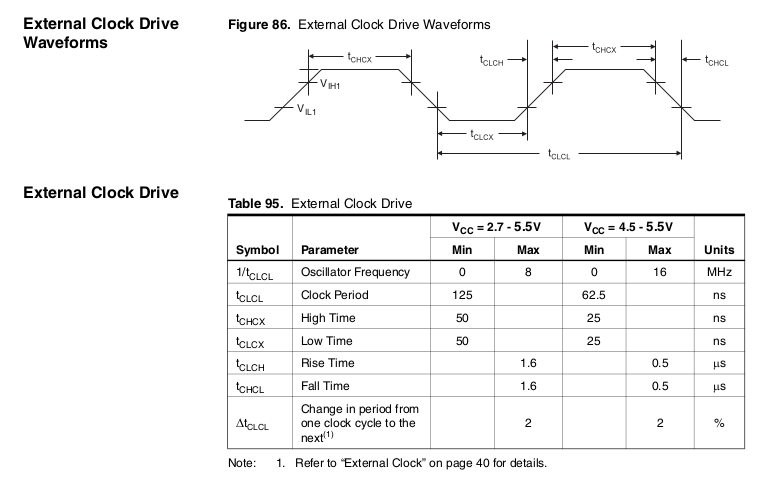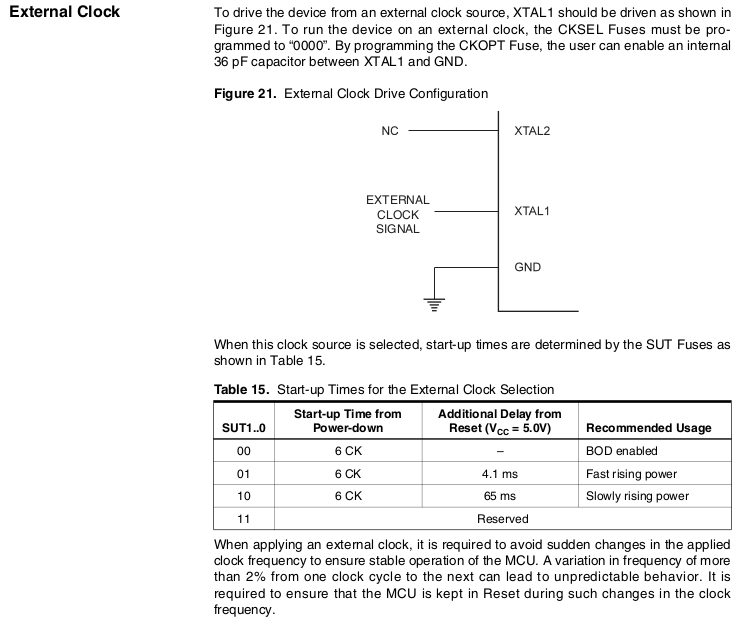A nice surprise, that I'll save for future-endeavors:

I figured OSCCAL would allow adjustment of the 8MHz (nominal) R/C oscillator with only a small variance in either direction, but here it seems I could adjust it to (roughly) Three Times the 8088 Bus Clock (14.31MHz)!
I've vague ideas of how to fine-tune that... maybe using an 8-bit timer/counter, and counting external 4.77MHz clocks until it overflows, counting internal clocks at the same time, and adjusting the OSCCAL value until we get ~768 internal clocks between timer-interrupts. That'd probably be accurate-enough... Especially if I have a routine that waits until an edge is detected before starting each bus-transaction.
It's entirely plausible it'll sync-up somewhere mid-clock, and that's something I'll be pondering. Maybe it means we can only, reliably, execute two timing-sensitive instructions per bus-clock... I dunno.
---------------
External-clocking at 4.77MHz (1:1 AVR/8088 clocking) also seems feasible (and would certainly be easiest for these early experiments):

Note, no mention of duty-cycle. (and, in fact, the drawing isn't even close to 50%!)

(because, the 8088's clock is 4.77MHz with 33% duty-cycle).
-------------
Finally: I think I've managed to whittle down the bus-transaction such that with 1:1 clocking, the AVR should be able to keep up within the requirements of external memories and I/O (and the 8288). (Though, NOT, the 8087 and DMA controller... which I'll leave uninitialized for now).
#define S20_INT_ACK 0x0
#define S20_READ_IO 0x1
#define S20_WRITE_IO 0x2
#define S20_HALT 0x3
#define S20_INSN_FETCH 0x4
#define S20_READ_MEM 0x5
#define S20_WRITE_MEM 0x6
#define S20_PASSIVE 0x7
#define S20_IDLE S20_PASSIVE //my own naming...
void bus88_write(uint8_t s20, uint32_t address, uint8_t data)
{
//////
// 4.77MHz = 209.6ns
// clock-high = 33% duty-cycle = 69.88ns
// clock-low = 66% = 139.76ns
//////
//AVR latches inputs on the falling-edge
// 'in R17, PINA' is valid *half* a period after, or in the *next*
// clock-cycle
// (and R17 contains the value at the rising edge of the one following)
//
//AVR latches *outputs* on the rising-edge *after* the instruction
// completes.
//Note, all AVR-OUTPUTs, here, are expected within ~20ns after bus's
// Falling-edge
// all AVR-INPUTs, here, are expected within ~20ns after bus's
// Rising-edge
// So, maybe a 7404, or something, could be found with ~20ns
// propagation-delay, and wired between the bus-clock and the AVR
// clock-input.
// Or, chain a few inverters in series.
// (Believe it or not, this was once a go-to method for synchronizing
// digital logic... Sometimes you'll even find a production-board with
// a chain of inverters and a clock-signal hand-wired to a point
// somewhere inbetween)
//### Bus is idle (assumed) ###
//So, it should be OK to prep our Address bytes
ADDR1916_PORT = (uint8_t)(address>>16); //assuming bits 20-24 are 0
ADDR158_PORT = (uint8_t)(address>>8);
ADDRDATA70_PORT = (uint8_t)(address);
//Begin the Bus transaction
//Per 8288:
// This should happen between tCHSV after _|¯ and tSVCH before next
// tCHSV = Status Active Hold Time >= 10ns after _|¯
// tSVCH = Status Active Setup Time >= 35ns before next(?!) _|¯
// So, basically, somewhere around T1's entry ¯|_
S20_PORT = s20; // OUTPUT, AROUND: ¯|_
// The 8288 will bring ALE High...
// Either from the clock ¯|_, or from S20 ¯|_, if after clock
// ¯|_ ### T1 ###
// Normally, Addresses would be setup here,
// but we're fudging the timings a bit...
// They've already been done.
// The 8288 will bring ALE Low in 4-15ns after _|¯
//Nothing to do?!
// Gotta keep the timing aligned...
asm("nop;");
// ¯|_ ### T2 ###
// "T2 is used primarily for changing the direction of the bus during
// read operations" -- 8088-CPU.pdf
// The 8288 will bring /AMWC, /AIOWC, etc. low in 10-35ns after ¯|_
// for "advanced" (early) write-signals
// (Not really important to note here)
// FOR READ: This is the same time where /MRDC, or /IORC occurs
//TODO: Should probably make sure the ALE pulse is recognized
// by other devices, before we change AD7:0
// BUT: it's already been half a clock-period, right?
// So should be fine...
// ALSO, if we meet/exceed the 8088's minimum timings, here,
// then it should be fine.
//Put the data-to-write on the port
//8088: TCLAX ¯|_ -> A19:16 -> S6:3 Address Hold >= 10ns
// TCLAZ ¯|_ -> AD7:0 -> Float (READ) Address Float Delay 10-80ns
// TCLDV ¯|_ -> AD7:0 -> Data (WRITE) Address Valid Delay 10-110ns
ADDRDATA70_PORT = data; //OUTPUT: >10ns AFTER ¯|_
//Technically: A19:16 -> S6:3 is also supposed to happen here
// but for now we're not using the 8087, nor DMA, so should be OK(?)
// ¯|_ ### T3 / Tw ###
// The 8288 will bring /MWC, /IOWC, etc. low in 10-35ns after ¯|_
// for *non*-advanced/non-early write-signals
//It's not possible to read the READY signal, test it, then jump
// all in a single AVR cycle
//Thankfully, it seems the 8288 is triggered only by /S2:0
// And the processor is the only thing that pays attention to READY
// And, nothing else is expected of the processor outputs during T3/Tw
//So, we can insert our own "wait-states"
// in the form of internal processing-time, then return /S2:0 to "idle"
// when it's complete
//According to one diagram (showing READY being sampled!)
// READY should be sampled with ¯|_ entering T3/Tw
// in 8088-CPU.pdf p10
//According to another diagram, READY should be sampled with _|¯
//!!! TRYLCL could be up to 8ns *into* T3 (but not Tw)
// TRYHCH setup time > 118ns to _|¯ mid T3/Tw!!!
// TCHRYX hold-time > 30ns after _|¯
// in 8088-CPU.pdf p23
//Confusing, but the actual *timings* suggest _|¯
//
// OK, sample READY on _|¯
while(!(READY_PIN & READY_MASK)) {}; //INPUT: <30ns AFTER _|¯
//NOTE That we'll be in a later Tw, at this point... weeee!
//Indicate that we're done with wait-states, and ready to enter T4
//8088: TCLSH Status Inactive Delay: after ¯|_ 10-130ns
S20_PORT = S20_IDLE; //OUTPUT: >10ns AFTER ¯|_
// ¯|_ ### T4 ###
// The 8288 will bring /IOR, /IOW, etc. high within 10-35ns of ¯|_
// We're not reading, so we don't need to sample ADDRDATA_PIN
// But, for READ, it should be done quickly after ¯|_, or maybe before
// 8288 timing shows Write Data Valid as acceptably valid after T4
// Same likely goes for A19:8... (whew!)
//Nothing to do?!
asm("nop;");
// ¯|_ ### BUS IDLE ###
// WARNING: This is NOT compatible with DMA and 8087!
}
In case you didn't catch that, lemme take out the majority of the comments:
ADDR1916_PORT = (uint8_t)(address>>16); //assuming bits 20-24 are 0
ADDR158_PORT = (uint8_t)(address>>8);
ADDRDATA70_PORT = (uint8_t)(address);
S20_PORT = s20; // OUTPUT, AROUND: ¯|_
asm("nop;");
ADDRDATA70_PORT = data; //OUTPUT: >10ns AFTER ¯|_
while(!(READY_PIN & READY_MASK)) {}; //INPUT: <30ns AFTER _|¯
S20_PORT = S20_IDLE; //OUTPUT: >10ns AFTER ¯|_
asm("nop;");
SO MUCH SIMPLER than the earlier expectations, wherein I thought it would be darn-near impossible to get it running with a 4:1 AVR clock. And, here it should work with 1:1.
------------
I've still gotta wire this thing up, and the cat's being deprived, so it may be a while until I get a chance to check this out.
Thankfully, READ is pretty much identical, (and has been accounted-for in the comments)...
And it'd be pretty easy to e.g. use the AVR's UART (or just an LED) to indicate whether writes/reads to a low memory-address verify correctly. (A bit of a shout-out to comments in earlier logs, suggesting using the AVR's peripherals... I'd been planning to do some CGA video-output for my first "hello-world" but that's way overboard)
--------
And... the 8515 might just work with only a few pin-relocations, it's got a very similar pinout to the 8088.
 Eric Hertz
Eric Hertz
Discussions
Become a Hackaday.io Member
Create an account to leave a comment. Already have an account? Log In.